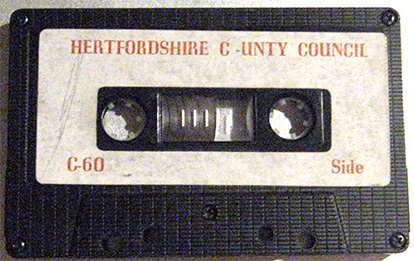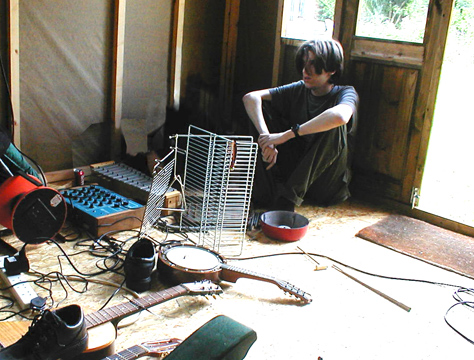 |
| Tapedropping: For Thee… |
It is frustrating to find that audio cassettes are now obsolete. I say this not out of nostalgia, but because cassettes were the ideal medium for mediadropping (that is, anonymously leaving homemade music in random places). Indeed, prior to the manifest decline of the cassette in around 2004, I referred to mediadropping as tapedropping. The neologism mediadropping came later.
Available here is a paper entitled Mediadropping Musings detailing the practice and philosophy of mediadropping / tapedropping. The essay formed part of a larger collection which were often dropped likewise in acts of pamphlet-dropping. This particular text is reproduced here with all its original faults, but remains a useful document for any effusionist.
The majority of people no longer own equipment to play cassettes. This practice of mediadropping is now almost completely thwarted by lack of suitable media. CD-dropping was experimented with, but CDs can also carry data. I have conducted wide-ranging dropping experiments using both CDs and tapes bearing email addresses in order to harvest responses. CD-droppings have low response rates. There is perhaps a sense that CDs can carry computer viruses or even just potentially *too graphic* multimedia experiences. This makes people loath to pick up a rogue CD-R, even if enticing cover art is provided. Cassettes, in contrast, are obviously meant for audio – tapes are mysterious Pandora’s boxes which rouse curiosity concerning their content.
 |
| Tapedropping: Bad Trad |
In recent years, tapes have become ‘cool’ again for their retro appeal in niche circles. These people who maintain the tape mantle are, however, too knowing to be targeted as tapedropping recipients. The ideal audience for tapedroppings are just ever-so-slightly leftfield of the middle-of-the-road, but generally uncaring shits – the very people who have now migrated from tape to the latest invisible mp3 zapping technology. It is a shame.
My own early tapedroppings were anything but ‘cool’. They were rabid affairs characterised by an element of ‘trolling’ (before the word came to represent foul cyber-desecrations of basic human decency). Early tapedroppings were directed at aggressors, muse-stiflers, intimidatingly dull bastards, etc. Often, the tapes smacked of puritanical fanaticism and stoic exhortation against the utterly arrogant sexual mores of tacky, brutish schoolboys.
 |
| Rough Music in Warwickshire, 1909 |
I noticed that these tapedroppings could bring about changes of behaviour in their targets. Beholders of rogue cassettes loudly voiced their concerns over the following days, playing detective to fathom the origins and purpose of the strange anti-gift. Answers were never forthcoming, but gossip and false information were: “Mr. Foulsham made that cassette because he hates your mum”, etc. Generally, a few weeks after receiving the cassette, the recipient became softer and less liable to abuse quieter people – a good thing. The effects weren’t so lasting on dyed-in-the-wool bullies, but certainly the ‘casual-bullies’ became more pleasant.
Countless tapes were deployed, but I tried to avoid targeting the same person twice or thrice. My philosophy was that you only get one chance at this kind of operation, so it had better be a good one! If a recipient were to receive a second tape, he would be more mentally prepared and its potency would be lost.
At some stage it became apparent that certain combinations of sounds, voice information, treatments and ‘instrumentation’ were more effective at affecting a target than others. Catchiness of chant or melody was certainly potent. Without referring back to a master tape, it was impossible to judge what compositions were the most successful. Until this point, I had been recording directly to cassette using my parents’ hi-fi and dubbing extra tracks by using the second tape deck. At a car boot sale around 1998, I obtained a four-track, so I began constructing ‘stock’ backing tracks, leaving space for different voice dubbings each time to be tailored for the specific target. The four-track machine enabled the re-use of certain flights of sound combinations and the retaining of copies.
At college, a more altruistic route was taken with the tapedroppings. I reverted back to cassette and randomly made tapedroppings on a near-industrial scale all around public places. I mainly strove to create an interesting listening experience for random people who happened to stumble across the tapes. Encouragement was also given in the supplementary sleeves for the random recipient to create his/her own sonic deployments. I wanted to hear what other people were sonically capable of when all obligations to follow musical trends were discarded. Crucially, an email address was provided on the tapes. Email allowed for recipient feedback, and many responses were harvested this way. With catalogue numbers on each cassette, the recipient could be asked to cite the number, and thus the actual material would be identified and subsequently honed further and further toward the most reaction-eliciting sonics.
The document Mediadropping Musings highlights the various shades of severity in tapedropping sentiment. I have divided these into three categories: Subdued, Burlesque and Wayward. The dangers of ‘wayward’ mediadroppings are also detailed therein. Without the surreal, artistic, fantastical, incoherent and abstract elements, mediadropping can be hijacked by the aforementioned “dull bastards” who may use anonymity to extend their bullydom and make comically sick provocations to strangers. This is what we see happening online with the ‘unacceptable’ face of ‘trolling’. It is vital, therefore, that the mechanics of mediadropping are understood in order to “troll the troll” in attempts to restore equilibrium where possible. In the digital age, it is, sadly, difficult to coerce people to play unsolicited audio from an unknown web source. Here’s hoping a new physical audio format suited to mediadropping may emerge in the future!






